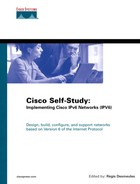N - P
- NAP.
Network Access Point. A neutral place where ISPs can interconnect and exchange IPv6 routes and traffic.
- NAT.
Network Address Translation. A mechanism that typically translates IPv4 packets from networks based on private addressing to the IPv4-Internet or to other private networks. See RFCs 1631 and 1918.
- NAT-PT.
Network Address Translation Protocol Translation. NAT-PT translates IPv6 addresses into IPv4 addresses and vice versa. The NAT-PT is a transition and coexistence mechanism that allows IPv6-only nodes to communicate with IPv4-only nodes. See RFC 2766.
- neighbor advertisement (NA).
An ICMPv6 type 136 message is the response sent by an IPv6 node that has received a neighbor solicitation message from another IPv6 node. Neighbor solicitation replaces ARP.
- Neighbor Discovery Protocol (NDP).
A protocol that defines several mechanisms that are built into IPv6, such as prefix advertisement, duplicate address detection, ARP replacement, and router redirection. NDP uses ICMPv6 message types 133 through 137. See RFC 2461.
- neighbor solicitation (NS).
An ICMPv6 type 135 message sent by an IPv6 source node to solicit another IPv6 node on the local link. Neighbor solicitation is used to replace ARP and for duplicate address detection.
- NGtrans.
An IETF working group that has designed tools, protocols, and strategies allowing the transition of IPv4 networks to IPv6.
- OSPFv3.
Open Shortest Path First version 3. The IPv6 counterpart of OSPFv2. OSPFv3 is an IGP. See RFC 2740.
- path MTU discovery (PMTUD).
A mechanism that allows a source node to detect the largest MTU value along a delivery path to a destination node.
- pseudo-TLA (pTLA).
On the 6bone, the pseudo-TLAs are the backbone providers that are connected to each other. pTLAs are equivalent to the Tier-1 providers on the IPv4-Internet.
